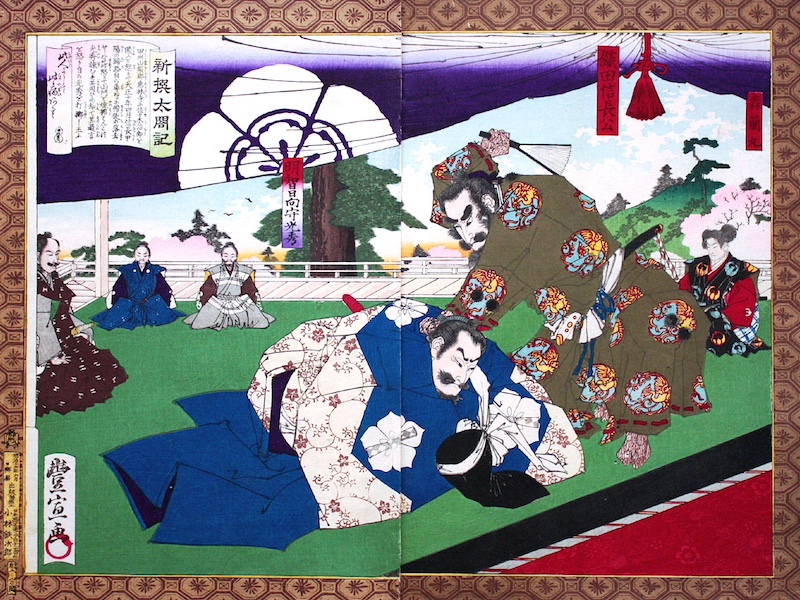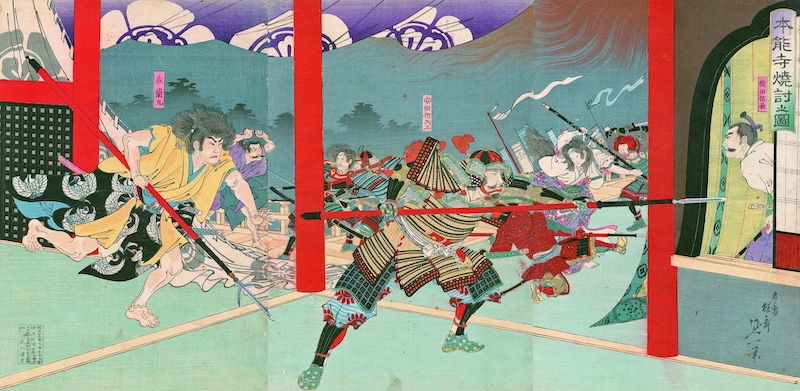Apr 30, 2024
Akechi Mitsuhide – The Chūbu Traitor Who Shaped Japan
If you’ve been watching the epic Disney+ remake of Shōgun (and if you’ve not, you need to remedy that!) then you most likely have been impressed by the character Lady Mariko. A strong woman in a male-dominated world, she is by far the best (or at least well-rounded) character. Perhaps what makes her so intriguing is that much of her strength comes from her desire to atone for her father’s treachery. However, her character becomes even the more impressive when you realise that she is based on a real person – Hosokawa Gracia. Furthermore, not only was the treachery of her father just as real, monumentally shifting the passage of Japanese history, it has its origins right here in the Chūbu region.
Who was Akechi Mitsuhide?
The name Akechi Mitsuhide echos down the centuries for his betrayal of Japan’s first great unifier, Oda Nobunaga, an act that some consider the defining moment of the late Warring States era. However, that one ruthless incident should not entirely define him. Born around 1528 in Mino Province (modern day Kani in Gifu Prefecture), he was destined for greatness from childhood, groomed in warfare by the ruthless warrior Saitō Dōsan, the “Viper of Mino”. Yet, after Dōsan’s son, Saitō Yoshitatsu, rose up and defeated his father in 1556, the victor punished Mitsuhide for siding with his father by destroying his ancestral home, Akechi Castle, with Mitsuhide (as some accounts have it) barely escaping with his life.
Thus exiled from Mino, Akechi floated from clan to clan, before coming under the command of would-be-shōgun Ashikaga Yoshiki, himself banished from Kyoto. Seeking a powerful daimyō [warlord] to help him wrest control of Kyoto from his clansman Ashikaga Yoshihide, Yoshiki asked Mitsuhide who he would recommend as his ‘protector’ (i.e. puppet master). The obvious choice for Mitsuhide was Oda Nobunaga, the ruthless rampaging daimyō, and husband to his childhood friend and daughter of Saitō Dōsan. As a result, after marching on Kyoto, assisted by the sudden death of Yoshihide from contagious disease (things like that tended to happen to the opponents of Nobunaga), the Oda clan took command and installed Yoshiki as shōgun.
Cracks appear
However, the alliance between Yoshiki and Nobunaga was not a marriage of convenience destined for the ages, and Mitsuhide when push came to shove he turned his allegiance to the increasingly powerful Oda clan. Throughout the 1570s, as Nobunaga waged bloody war against his opposing samurai clans, as well as the brutal slaughter of the Ikko Ikki residing in the area of Mt. Hiei, it was Mitsuhide who was regularly at the forefront of every charge and defining battle. With each victory, he rose in Nobunaga’s estimation, who rewarded his loyal retainer with increasing power.
As tended to happen when Nobunaga was around, allegiances were tested and tempers frayed, however. There are stories that have Akechi rebuked by outbursts of Nobunaga’s temper, embarrassed by reprimands in front of others, and there is even an Edo-era print that depicts Nobunaga striking his loyal retainer in full view of other daimyō. Of course, these representations are non-contemporaneous, and must be taken with a healthy pinch of salt, however they are not without plausibility, as Nobunaga’s rage was as famed as his ruthlessness. It was this latter trait that perhaps pushed Mitsuhide over the edge.

In 1579, Akechi captured Yamaki Castle (in modern-day Hyogo Prefecture) by promising its incumbent, Hatano Hideharu, safe passage. Oda records indicate that Mitsuhide achieved this by offering up his own mother in surety, though when Hideharu surrendered in apology to Nobunaga, the despotic ruler had Hideharu killed. Understandably upset by this subterfuge, the Hatano clan executed Mitsuhide’s mother in revenge, presumably enraging the bereaved Mitsuhide. Despite these apparent strains in the Mitsuhide-Nobunaga relationship (though there is little contemporaneous evidence for these affronts, many of which appear first in Edo era tales), in 1580 Nobunaga named his trusted retainer as his number one general. It appeared that Oda Nobunaga was on the cusp of unifying Japan under his control, with Akechi Mitsuhide his right hand man, and as such, what happened just two years later, has left historians scratching their heads ever since.
Trechory abounds
In 1582, Nobunaga ordered Mitsuhide to head west to join the battle against the defiant Mōri clan. Instead, he turned his 13,000 soldiers against Nobunaga, who was residing in one of his favourite temples, Honnō-ji in Kyoto. Akechi had his men surround the temple and, saying “The enemy is at Honnō-ji”, had the place set ablaze. It remains unclear how Nobunaga died – whether in battle or by his own hand – but with his one-time master gone, Mitsuhide, who now claimed the title of shōgun, had to act fast. He made attempts to curry favour with the other clans in the Imperial Court, though the shock of his betrayal saw his pleas fall on deaf ears; even the Hosokawa clan – to whom he was tied through the marriage of his daughter, the aforementioned Lady Gracia – turned their back on him.

Having learned of his lord’s execution, Toyotomi Hideyoshi sued for peace against the Mori, and headed to Kyoto, racing against Tokugawa Ieyasu to be the first to avenge Nobunaga’s death. Hideyoshi was the fastest, and lined up his 20,000 men against Mitsuhide’s dwindling army at the Battle of Yamazaki. The Akechi forces were in disarray and the Toyotomi overran them, with Mitsuhide ambushed and killed by bandits as he fled the battle, just one month after his slaying of Nobunaga.
The end of one man; the start of a new era
The motives for Akechi Mitsuhide’s coup d’état remain foggy to this day. Was he riled by Nobunaga’s constant outbursts of anger? Perhaps he could not forgive the death of his mother due to Nobunaga’s calouslessness. It is even possible that he disagreed with Nobunaga’s tyranny, and feared for the nation’s future under Oda rule. Or it could be that it was an opportunistic – if ill-conceived – grasp for power. Whatever his motives, the figure of Akechi Mitsuhide looms large in the Japanese psyche, part underdog hero, part treacherous villain, part enigma. Whatever he was, it was his assassination of Oda that allowed Toyotomi Hideyoshi to unite Japan under one banner, and it was his death that led not only to the story of the TV series Shōgun, but to the the 200 years of Tokugawa rule that define Japan to this day.
Image: via wikicommons [Public Domain]
Image: via wikicommons [Public Domain]
Image: via wikicommons [Public Domain]


About the author